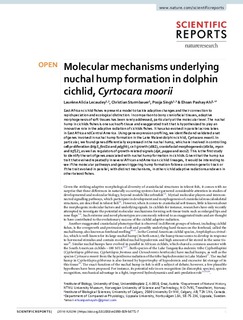| dc.contributor.author | Lecaudey, Laurene Alicia | |
| dc.contributor.author | Sturmbauer, Christian | |
| dc.contributor.author | Singh, Pooja | |
| dc.contributor.author | Ahi, Ehsan Pashay | |
| dc.date.accessioned | 2020-01-06T08:05:43Z | |
| dc.date.available | 2020-01-06T08:05:43Z | |
| dc.date.created | 2020-01-02T15:43:17Z | |
| dc.date.issued | 2019 | |
| dc.identifier.citation | Scientific Reports. 2019, 9 (20296). | nb_NO |
| dc.identifier.issn | 2045-2322 | |
| dc.identifier.uri | http://hdl.handle.net/11250/2634900 | |
| dc.description.abstract | East African cichlid fishes represent a model to tackle adaptive changes and their connection to rapid speciation and ecological distinction. In comparison to bony craniofacial tissues, adaptive morphogenesis of soft tissues has been rarely addressed, particularly at the molecular level. The nuchal hump in cichlids fishes is one such soft-tissue and exaggerated trait that is hypothesized to play an innovative role in the adaptive radiation of cichlids fishes. It has also evolved in parallel across lakes in East Africa and Central America. Using gene expression profiling, we identified and validated a set of genes involved in nuchal hump formation in the Lake Malawi dolphin cichlid, Cyrtocara moorii. In particular, we found genes differentially expressed in the nuchal hump, which are involved in controlling cell proliferation (btg3, fosl1a and pdgfrb), cell growth (dlk1), craniofacial morphogenesis (dlx5a, mycn and tcf12), as well as regulators of growth-related signals (dpt, pappa and socs2). This is the first study to identify the set of genes associated with nuchal hump formation in cichlids. Given that the hump is a trait that evolved repeatedly in several African and American cichlid lineages, it would be interesting to see if the molecular pathways and genes triggering hump formation follow a common genetic track or if the trait evolved in parallel, with distinct mechanisms, in other cichlid adaptive radiations and even in other teleost fishes. | nb_NO |
| dc.language.iso | eng | nb_NO |
| dc.publisher | Nature Research | nb_NO |
| dc.rights | Navngivelse 4.0 Internasjonal | * |
| dc.rights.uri | http://creativecommons.org/licenses/by/4.0/deed.no | * |
| dc.title | Molecular mechanisms underlying nuchal hump formation in dolphin cichlid, Cyrtocara moorii | nb_NO |
| dc.type | Journal article | nb_NO |
| dc.type | Peer reviewed | nb_NO |
| dc.description.version | publishedVersion | nb_NO |
| dc.source.pagenumber | 13 | nb_NO |
| dc.source.volume | 9 | nb_NO |
| dc.source.journal | Scientific Reports | nb_NO |
| dc.source.issue | 20296 | nb_NO |
| dc.identifier.doi | 10.1038/s41598-019-56771-7 | |
| dc.identifier.cristin | 1765426 | |
| dc.description.localcode | Open Access This article is licensed under a Creative Commons Attribution 4.0 International License, which permits use, sharing, adaptation, distribution and reproduction in any medium or format, as long as you give appropriate credit to the original author(s) and the source, provide a link to the Creative Commons license, and indicate if changes were made. The images or other third party material in this article are included in the article’s Creative Commons license, unless indicated otherwise in a credit line to the material. If material is not included in the article’s Creative Commons license and your intended use is not permitted by statutory regulation or exceeds the permitted use, you will need to obtain permission directly from the copyright holder. To view a copy of this license, visit http://creativecommons.org/licenses/by/4.0/. | nb_NO |
| cristin.unitcode | 194,31,10,0 | |
| cristin.unitname | Institutt for naturhistorie | |
| cristin.ispublished | true | |
| cristin.fulltext | original | |
| cristin.qualitycode | 1 | |

